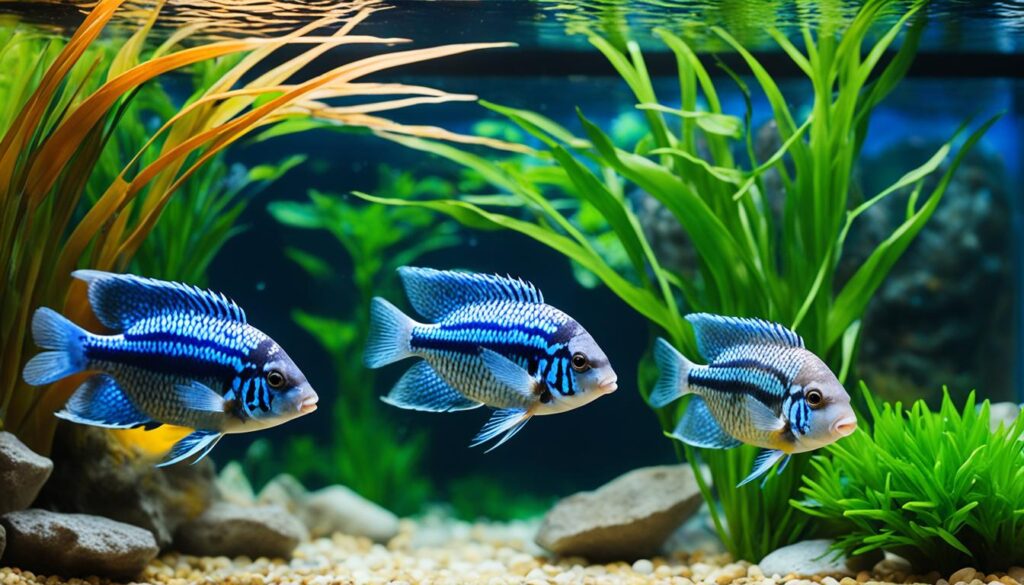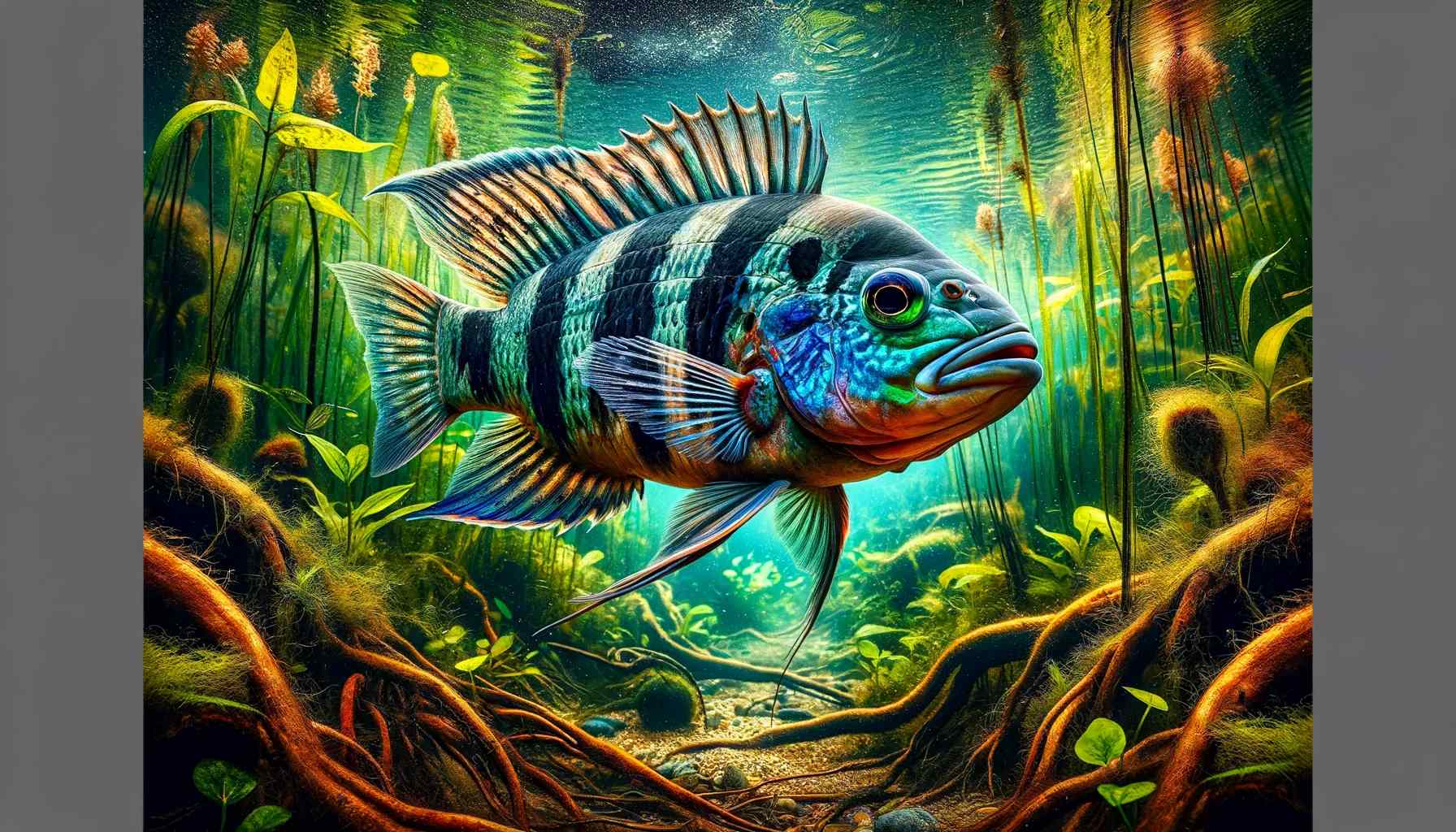This post contains affiliate links.
Key Takeaways:
- Wolf cichlids can grow up to 72 cm (28.5 inches) in size.
- They are highly predatory and require large aquariums.
- Wolf cichlids are found in Central America, particularly in Honduras, Nicaragua, and Costa Rica.
- These cichlids prefer a pH range of 6.5-7.0 and a temperature range of 22-27°C (72-81°F).
- Stay tuned to discover the top five destinations where you can catch a Wolf cichlid!
Wolf Cichlid Habitat and Range
When it comes to the habitat of the Wolf cichlid, rivers are its preferred residence. However, this highly adaptable species is also capable of thriving in lakes and other slower-moving bodies of water. It can be found in a vast area that stretches from the Aguan River in Honduras to the Moín River in Costa Rica on the Atlantic side of Central America. On the Pacific side, you’ll spot the Wolf cichlid from the Yeguare River in Honduras to the Bebedero River in Costa Rica. Interestingly, there are indications of established populations of Wolf cichlids in Florida as well, bringing this captivating species closer to home.Welcome to the Central American waters!
As you venture into the rivers teeming with life, you’ll encounter the striking Wolf cichlid in its natural habitat. From the Aguan River to the Moín River on the Atlantic side, this species has claimed its domain, commanding attention with its vibrant presence. Journeying over to the Pacific side, from the Yeguare River to the Bebedero River, you’ll witness the same awe-inspiring sight. And who knows? You might even stumble upon a Wolf cichlid cruising along in the Florida waters, bringing a taste of Central America to the Sunshine State.“Rivers are nature’s ever-flowing pathways, and they serve as the perfect playground for the Wolf cichlid to roam.” – Professional Aquarist
| Location | Habitat | Range |
|---|---|---|
| Aguan River | Rivers | Honduras to Costa Rica |
| Moín River | Rivers | Honduras to Costa Rica |
| Yeguare River | Rivers | Honduras to Costa Rica |
| Bebedero River | Rivers | Honduras to Costa Rica |
| Florida | Rivers, Lakes | Established Populations |
Description of Wolf Cichlid
Meet the fascinating Wolf cichlid, a sleek and mesmerizing creature with a silver shimmer that captures the eye. Its slender body is adorned with a bold black stripe that stretches across its entire length, adding a touch of mystique to its appearance. But what truly sets this cichlid apart are the pearl-like spots along the black stripe, each one with delicate grey bands extending upwards, creating an enchanting pattern.The Wolf cichlid’s striking coloring doesn’t stop there. The lower half of its body boasts a vibrant brightness, contrasted by the darker hue of the upper half. This unique combination of colors and patterns makes the Wolf cichlid a true standout in any aquarium.However, it’s not just its appearance that makes the Wolf cichlid captivating. With a fierce and predatory nature, this cichlid lives up to its name. It exhibits aggressive behavior, dominating its territory with authority and asserting its position as the alpha of the tank. It’s a creature of strength and tenacity, a true wolf among fishes.Characteristics of the Wolf Cichlid:
- Slender body with a silver shimmer and a hint of green
- Prominent black stripe running across the body
- Pearl-like spots on the black stripe with grey bands
- Bright lower half of the body, contrasting with a darker upper half
- Predatory nature and aggressive behavior
Wolf Cichlid Care and Tank Setup
When it comes to caring for a Wolf cichlid, you need to create an environment that caters to its unique needs. As a large and aggressive fish, the Wolf cichlid requires a spacious tank to thrive. A minimum tank size of 130 gallons is recommended for juveniles and smaller adults, but keep in mind that fully grown Wolf cichlids will need even larger tanks to accommodate their size.While setting up the tank, it’s essential to create a natural habitat for the Wolf cichlid. Decorate the tank with plenty of rocks and roots, providing ample hiding spots and territorial boundaries. These fish are avid diggers, so a sandy substrate is preferred. Additionally, ensure proper filtration as the Wolf cichlid produces a significant amount of waste, which can quickly deteriorate water quality.The ideal water conditions for a Wolf cichlid include a pH level of 7 and a temperature range of 22-27°C (72-81°F). Maintaining stable water parameters is crucial for their overall well-being.| Wolf Cichlid Care and Tank Setup | Key Points |
|---|---|
| Tank Size | Minimum 130-gallon tank; larger tanks required for fully grown adults. |
| Decoration | Use rocks and roots to create hiding spots and territorial boundaries. |
| Substrate | Preferably sand to cater to the cichlid’s digging behavior. |
| Filtration | Strong filtration system to handle the cichlid’s waste production. |
| pH Level | Optimal pH of 7 to maintain a healthy environment. |
| Temperature | Keep water temperature between 22-27°C (72-81°F). |
Compatible Tankmates for Wolf Cichlid
When it comes to tankmates for Wolf cichlids, you’ll need to think big and tough. These highly aggressive and predatory fish require companions that can hold their own against their feisty nature.So, who can swim in the same waters as the formidable Wolf cichlid? Tankmates should be large and robust, able to withstand any potential clashes. Here are some potential candidates to keep alongside your Wolf cichlid:- Large Central/South American cichlids: These sturdy cichlids can match the Wolf cichlid’s aggression and provide an exciting display of territorial behavior.
- Large armoured catfish: With their tough armor, these catfish are well-equipped to handle the Wolf cichlid’s aggression. They make excellent bottom-dwelling companions.
- Arowana: These elegant, predatory fish can coexist with the Wolf cichlid, as long as there is ample space and the tank is adequately sized.
- Stingrays: These graceful creatures can hold their own in the tank and add a unique touch to your aquatic display.

Here’s what others have to say:
“My Wolf cichlid has a feisty personality, so I’ve chosen tankmates that can hold their own. It’s like having the ocean in my living room!” – David S., Miami, FL
“Pairing my Wolf cichlid with some large Central American cichlids has created an impressive underwater battleground. It’s like watching an aquatic wrestling match!” – Sarah L., Austin, TXAs these satisfied aquarists have discovered, finding compatible tankmates for your Wolf cichlid can add an extra layer of excitement to your aquarium. Just remember to choose wisely and closely monitor their interactions for a harmonious aquatic environment.
Feeding the Wolf Cichlid
When it comes to feeding your Wolf cichlid, you need to keep in mind one thing: they are opportunistic predators. These voracious eaters will devour anything that can fit in their mouths, so it’s important to offer them a varied diet that meets their nutritional needs. Here are some feeding recommendations to keep your Wolf cichlid satisfied and healthy:- Start with high-quality pellets specially formulated for carnivorous cichlids. Look for options that contain a mix of protein sources to ensure a balanced diet.
- Supplement their diet with flakes designed for predatory fish. These flakes often contain a higher concentration of protein to meet the Wolf cichlid’s dietary requirements.
- Offer frozen foods such as shrimp, krill, or bloodworms. These options provide a natural and nutritious source of food, and the cichlids will relish the opportunity to hunt their prey.
- Occasionally, you can tempt your Wolf cichlid with live prey like feeder fish or ghost shrimp. However, make sure to only offer live food as a treat and not as the sole diet to prevent the introduction of diseases.
- Another option is to include meaty foods in their diet, such as beef heart. These high-protein options will help keep your Wolf cichlid in top shape.
Your Wolf cichlid will appreciate a varied menu that simulates their natural feeding behavior. By offering different food types, you’ll provide them with essential nutrients and prevent dietary deficiencies. Remember, a well-fed Wolf cichlid is a happy and healthy one!
Breeding the Wolf Cichlid
Breeding the Wolf cichlid can be quite the adventure. It’s a challenge that not only tests your skills as a fish keeper but also rewards you with the joy of new life in your aquarium. To successfully breed these magnificent creatures, there are a few key things to keep in mind.Establishing a Compatible Pair
The first step to successful breeding is to establish a compatible pair of Wolf cichlids. To do this, it’s recommended to obtain a group of juveniles and let nature take its course. Allow the fish to interact and form natural pairings. It may take time, but when you see a strong bond forming between two individuals, you’ll know you’ve found your pair.The Miracle of Life
Once you have your pair, the magic begins. The female Wolf cichlid will lay up to 1500 eggs on a flat surface, usually glass. The male will fertilize them with his milt, and both parents will take turns guarding the precious eggs. It’s truly a sight to behold.Raising the Fry
After a few days, the eggs will hatch, and the fry will emerge. At this point, the parents become fiercely protective of their offspring. It’s important to provide ample hiding spots and cover in the tank to ensure the survival of the fry. They can be fed crushed flakes, brine shrimp, and crushed freeze-dried food to give them the nutrients they need to grow strong and healthy.A Happy Home for Everyone
As the fry grow, they will quickly outgrow a typical home aquarium. It’s essential to have a plan for rehoming the potentially large number of fry. Consider reaching out to local aquarium societies, fish stores, or fellow fish enthusiasts who may be interested in providing a suitable home for these young Wolf cichlids.Remember, breeding the Wolf cichlid is an exciting and challenging endeavor. It requires patience, dedication, and a deep appreciation for the miracle of life. But the reward of seeing your aquarium filled with vibrant, energetic fry is well worth the effort.| Benefits of Breeding the Wolf Cichlid | Challenges of Breeding the Wolf Cichlid |
|---|---|
| – Witness the miracle of life | – Finding a compatible pair |
| – Expand your fishkeeping skills | – Ensuring proper tank conditions |
| – Share the joy of new life with others | – Caring for and feeding the fry |
| – Contribute to the conservation of the species | – Rehoming the growing number of fry |

Tips from a Wolf Cichlid Keeper
Are you ready to become a Wolf cichlid keeper? Here are some valuable tips from experienced keepers to help you create a thriving environment for your magnificent aquatic predator.1. Keep Them Entertained
Did you know that Wolf cichlids love to play? Providing them with diversions not only keeps them entertained but also promotes their well-being. Consider giving them ping pong balls to chase around or creating a habitat with plenty of hiding places and territorial borders in the tank. This will stimulate their natural instincts and provide them with hours of amusement.2. Maintain Water Quality
A clean and healthy environment is vital for the well-being of your Wolf cichlid. Regular water changes are crucial to keep the tank pristine and prevent the buildup of harmful substances. Invest in excellent filtration equipment to ensure optimal water quality. Remember, happy cichlids thrive in clean water!3. Consider the Commitment
Before bringing a Wolf cichlid home, it’s important to consider the commitment and space required to care for this species. As large and aggressive predators, they need ample room to swim and establish their territories. Make sure you have a spacious aquarium with appropriate tankmates and enough time and resources to care for these incredible creatures.| Tips | |
|---|---|
| 1 | Keep them entertained with ping pong balls and a diverse tank setup. |
| 2 | Maintain water quality through regular water changes and excellent filtration. |
| 3 | Consider the commitment and space required to properly care for a Wolf cichlid. |
Conclusion
So there you have it, the fascinating world of the Wolf cichlid. This highly predatory cichlid species found in Central America is certainly not for the faint of heart. If you’re considering keeping a Wolf cichlid, be prepared for the challenges that come with it, but also for the rewarding experience that awaits.First and foremost, make sure you have a spacious aquarium that can accommodate their large size. These cichlids need room to roam and express their natural behaviors. Additionally, choose tankmates wisely. The Wolf cichlid’s aggressive nature means they’re better off with large, robust species that can hold their own.Feeding your Wolf cichlid requires a varied diet to ensure their nutritional needs are met. Pellets, flakes, frozen foods, and even live prey can be part of their menu. And if breeding is on your mind, be prepared for the challenge. Establishing a compatible pair and finding suitable homes for the potentially large number of fry will require careful planning.Remember, keeping a Wolf cichlid is not a decision to take lightly. These unique creatures have specific needs and behaviors that must be met to ensure their well-being. But for those who are up to the task, the experience of caring for these magnificent predators can be truly rewarding.FAQ
What are the top five destinations to catch Wolf cichlid?
Where is the Wolf cichlid habitat and range?
How would you describe the Wolf cichlid?
What are the care and tank setup requirements for the Wolf cichlid?
What are compatible tankmates for the Wolf cichlid?
What should I feed the Wolf cichlid?
How do you breed the Wolf cichlid?
What are some tips from a Wolf cichlid keeper?
What are the main points to consider about the Wolf cichlid?
This post contains affiliate links.

